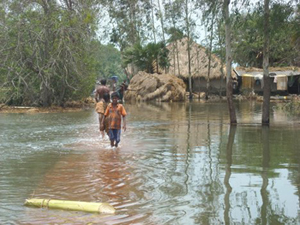Overview
Land subsidence is an environmental hazard which is caused by overdraft of groundwater,
coal mining or oil extraction and results in gradual settling or sudden sinking
of the earth’s surface owing to subsurface movement of the materials of the earth.
Subsidence is an inevitable phenomenon of ground movement caused by various manmade
and natural activities. The economic prosperity by the exploitation of the hidden
resources in the earth is always accompanied by the adverse impacts of subsidence.

Factors Favouring HailStorm
Hail is most common within continental interiors of the mid-latitudes, as hail formation
is considerably more likely when the freezing level is below the altitude of 11,000
feet (3,400 m).Movement of dry air into strong thunderstorms over continents can
increase the frequency of hail by promoting evaporational cooling which lowers the
freezing level of thunderstorm clouds giving hail a larger volume to grow in.Accordingly,
hail is actually less common in the tropics despite a much higher frequency of thunderstorms
than in the mid-latitudes because the atmosphere over the tropics tends to be warmer
over a much greater depth. Hail in the tropics occurs mainly at higher elevations.Hail
growth becomes vanishingly small when air temperatures fall below −30 °C (−22 °F)
as supercooled water droplets become rare at these temperatures.Around thunderstorms,
hail is most likely within the cloud at elevations above 20,000 feet (6,100 m).
Between 10,000 feet (3,000 m) and 20,000 feet (6,100 m), 60 percent of hail is still
within the thunderstorm, though 40 percent now lies within the clear air under the
anvil. Below 10,000 feet (3,000 m), hail is equally distributed in and around a
thunderstorm to a distance of 2 nautical miles (3.7 km).

Hazards of HailStorm
Hail can cause serious damage, notably to automobiles, aircraft, skylights, glass-roofed
structures, livestock, and most commonly, farmers' crops.Hail damage to roofs often
goes unnoticed until further structural damage is seen, such as leaks or cracks.
It is hardest to recognize hail damage on shingled roofs and flat roofs, but all
roofs have their own hail damage detection problems.Metal roofs are fairly resistant
to hail damage, but may accumulate cosmetic damage in the form of dents and damaged
coatings. Hail is one of the most significant thunderstorm hazards to aircraft.When
hail stones exceed 0.5 inches (13 mm) in diameter, planes can be seriously damaged
within seconds.The hailstones accumulating on the ground can also be hazardous to
landing aircraft. Hail is also a common nuisance to drivers of automobiles, severely
denting the vehicle and cracking or even shattering windshields and windows.Wheat,
corn, soybeans and tobacco are the most sensitive crops to hail damage.Hail is one
of Canada's most expensive hazards.Rarely, massive hailstones have been known to
cause concussions or fatal head trauma. Hailstorms have been the cause of costly
and deadly events throughout history. One of the earliest recorded incidents occurred
around the 9th century in Roopkund, Uttarakhand, India.The largest hailstone in
terms of diameter and weight ever recorded in the United States fell on July 23,
2010 in Vivian, South Dakota; it measured 8 inches (20 cm) in diameter and 18.62
inches (47.3 cm) in circumference, weighing in at 1.93 pounds (0.88 kg).This broke
the previous record for diameter set by a hailstone 7 inches diameter and 18.75
inches circumference (still the greatest circumference hailstone) which fell in
Aurora, Nebraska in the United States on June 22, 2003, as well as the record for
weight, set by a hailstone of 1.67 pounds (0.76 kg) that fell in Coffeyville, Kansas
in 1970.
